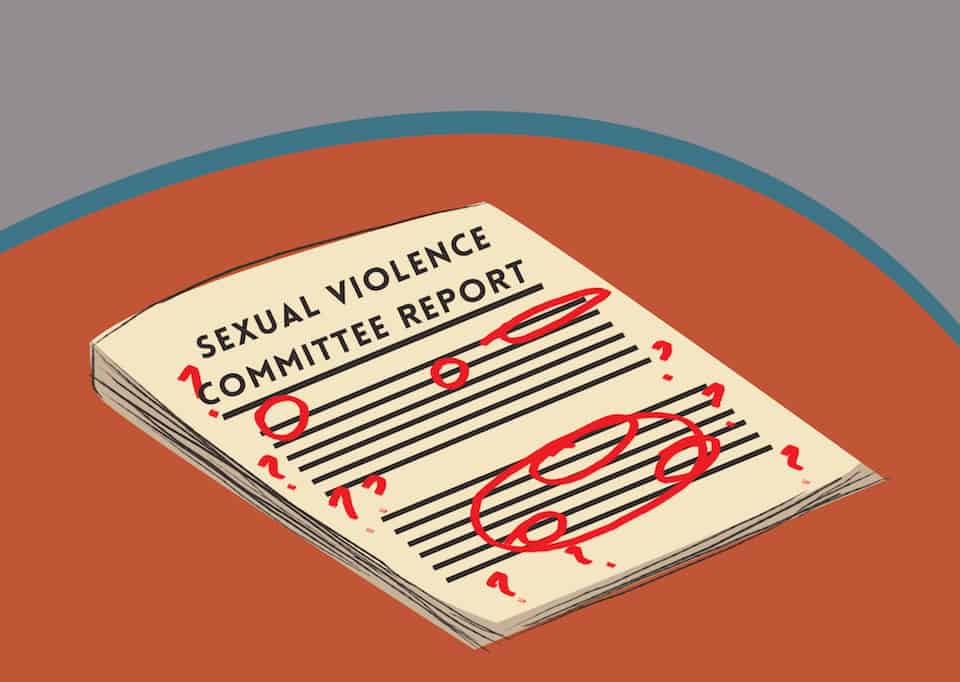[dropcap]F[/dropcap]rom the Dalhousie dentistry scandal in 2014 to a recent string of sexual assaults at the University of British Columbia, high profile occurrences of sexual misconduct have raised national concerns about sexual violence on university campuses. Students have consequently lobbied university administrations to implement sexual violence policies.
At U of T, that advocacy pressure has resulted in the creation of the Advisory Committee to the President and Provost on Preventing and Responding to Sexual Violence. The committee released their final report shortly before reading week, a decision that has been both a cause for criticism and for cautious optimism.
The committee’s process has been slow; it seems as though the issue has not been addressed with the urgency it deserves. It took the committee 15 months from the time it was first established to release their report, and it does not include any specific terminology or protocols for a new sexual violence policy at the university. This is slow compared to the single month it took Queen’s University to create an interim sexual assault support and response protocol in response to the Toronto Star’s investigation into sexual violence policies at different universities.
It is a weak excuse to say that bureaucratic, administrative processes hampered the committee’s ability to produce prompt recommendations. While policy is not created overnight, the administration should have certainly prioritized the issue. Given the gravity of the issue, it is unclear why our university did not move more quickly. Some recommendations require more research than others, but this should not exclude the possibility of an interim protocol or, at the very least, a clarification of existing procedures.
The committee also proposed that a “policy on sexual violence be created and begin with a clear affirmation that sexual assault and harassment will not be tolerated on campus.” Yet, the recommendation for the sexual violence policy is simply that — a recommendation. It does not indicate what rights will be afforded to survivors of sexual assault, nor does it offer specifics on how the procedure will work. This is not to mention that an institutional commitment to combatting sexual violence is a step forward, but such a simple statement could have been made much earlier.
Looking at Queen’s again: only one day after the Toronto Star published its review, the university’s principal and vice-chancellor wrote an article in the university publication The Gazette, affirming that “there is no tolerance for sexual assault in our community” and that “we have much work to do in this regard, but we have also made some significant strides.” Additionally, he outlined the steps the university was taking to combat sexual violence, projecting accountability to the broader community. U of T should aspire to have leaders that encourage similar attitudes.
To the committee’s credit, the suggestion to create one university sexual assault centre for reporting and providing support services is quite promising. It responds to how our current services for survivors overlap with each other, which makes them difficult to navigate. The committee’s other recommendation for university-wide education and training programs is essential for generating awareness and understanding about sexual violence among students, staff, and the community. It is commendable that the committee looks to combat “underlying attitudes and behaviours,” which are at the root of sexual violence. There is also a move toward accountability in shifting campus culture with the suggestion that “a regular campus climate survey [be] conducted.”
These benefits are offset by the fact that the committee’s report lacks any set deadlines for further discussion or policy. This lack of certainty leaves the progress on sexual violence in limbo, and makes it harder for students to hold the university responsible for producing anything in the near future.
The university’s choice not to make the report more public exists in the same vein. For all the emphasis on campus-wide education initiatives, there was a curious failure to disseminate the report via university list-servs. This is concerning because the committee purports to want feedback from students. Yet, this cannot occur unless students know what they should be responding to.
Soliciting more student feedback will ensure that the new policy reflects the specific concerns of this university, and that the implemented initiatives are appropriately tailored to our community
It is important that we recognize the limits of bureaucracy when responding to various complex social phenomena. Equally important, however, is to keep a critical but fair eye on those who wield institutional power. In this sense, the release of the committee’s report is bittersweet, and the fight against sexual violence is far from over.
Naomi Stuleanu is a second-year student at Victoria College studying criminology and psychology. Her column appears every three weeks.


